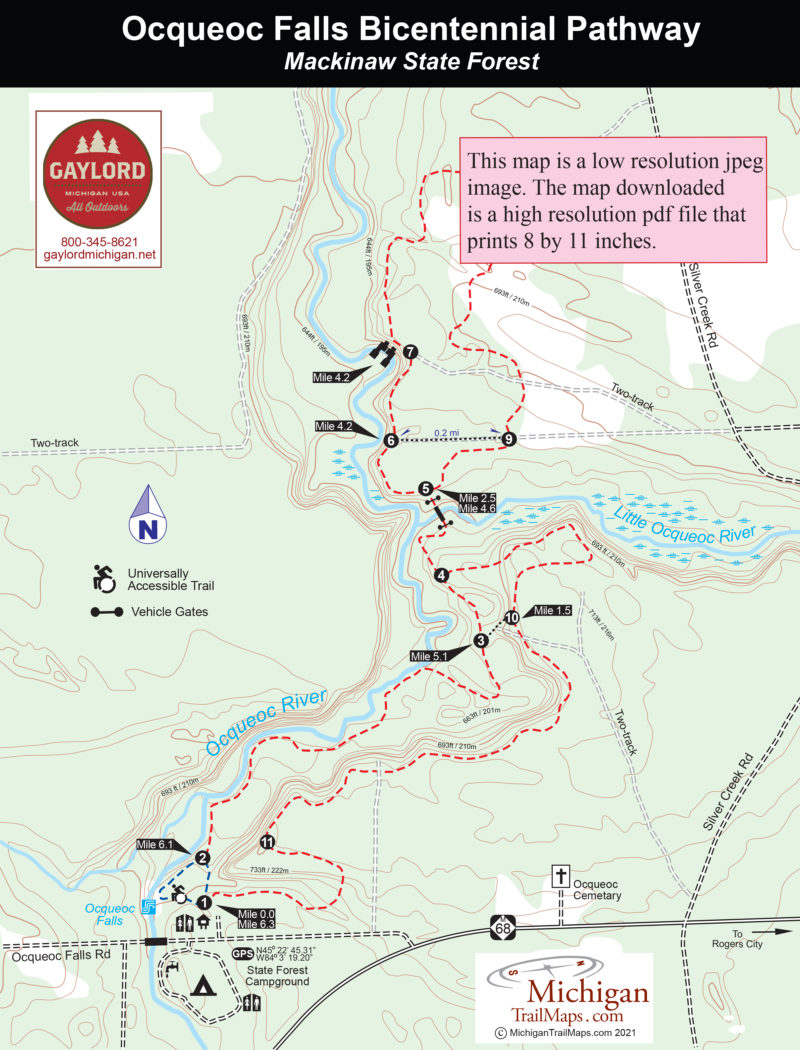6-Mile Loop
The trailhead is marked in the parking lot by a large display map and the pathway is numbered in a clockwise direction. This hike follows it in the opposite direction, saving the small cascade for the end. At post No. 1 head east (right) and follow an old two-track through a red pine forest along a surface that is solid for biking and usually carpeted by pine needles. You make a short climb and then level out for the next mile as you skirt a bluff, passing the view at post No. 11 at Mile 0.5. At times you can look down into the river valley or across to the forested ridge bordering the Ocqueoc on the west side.
The pathway will cross a number of old two-tracks throughout the day but in general is well marked and easy to follow. Just keep one eye out for blue DNR Pathway triangles on the trees or faded blue blazes. You cross one of the two-tracks at Mile 0.8 and then at Mile 1.5 arrive at post No. 10. To the west (left) is a very short downhill spur to post No. 3.
The 6-Mile Loop continues to the right and within a half mile makes a sharp swing to the west and descends off the bluff. At Mile 2.2 you arrive at post No. 4, a “T” junction and can head left for the cascade or right to continue north. Heading north you begin the two-way segment of trail, the result of the pathway being re-routed in the mid-2000s, and immediately arrive at a gate blocking motorized vehicles.
You descend to a steel bridge to cross the scenic Little Ocqueoc River and then climb out of the ravine to post No. 5 at Mile 2.5. Head right to continue the pathway in a counter clockwise direction but be aware of a confusing spot with a two-track just beyond the junction. At Mile 2.8 post No. 9 is reached at another spot that can also be confusing as it merges with a two-track but is well marked. The two-track serves as the crossover spur to post No. 6, The 6-Mile Loop heads left briefly to cross the two-track and then right to continue north.
Within a half mile you enter a meadow sprinkled with large trees that can be especially beautiful in the fall and at Mile 3.6 arrive at post No. 8 at a series of large boulders used to block to motorized vehicles, particularly ORVs. At this point the trail, resembling an old two-track, swings west to begin its return to the parking lot and at Mile 4.2 you emerge at what looks like forest road cul-de-sac. Nearby is post No. 7 and a bench perched on the edge of a high bank overlooking the Ocqueoc River. It’s your first view of the river if you didn’t sneak a peak of the falls in the beginning and it’s one of the best along the trail. You’re looking down at a sharp bend in the Ocqueoc and a long stairway providing anglers access to it.
A steep downhill follows and within a quarter mile you arrive at post No. 6 where there is another bench and a partial view of the river. Here an old two-track heads east (left) for post No. 9 while the main trail, also as an overgrown two-track, continues right along the bluff. Within a quarter mile you return to post No. 5 at the two-way single track and use it to re-cross the Little Ocqueoc River and return to post No. 4 at Mile 4.9.
This time continue straight along the more hilly terrain for post No. 3, reached in a quarter mile. After descending to the floor of the river valley. you arrive at the Ocqueoc at Mile 5.3 to begin the most scenic section of the trail. For the rest of the outing you remain close to the river to constantly catch views of gurgling trout stream through the trees. This stretch is one of the most beautiful river trails in the Lower Peninsula and ends with a universally accessible trail past the falls, heard long before you see them.
While not big by Upper Peninsula standards, Ocqueoc Falls makes for the perfect place to end a hike or a ride, especially on a hot summer afternoon. The cascade drops 10 feet over a series of three ledges, making it easy in the summer for you to kick off the boots and wade in for a soothing massage of the feet that only Mother Nature could give. The parking lot is just 100 yards or so to the east.







